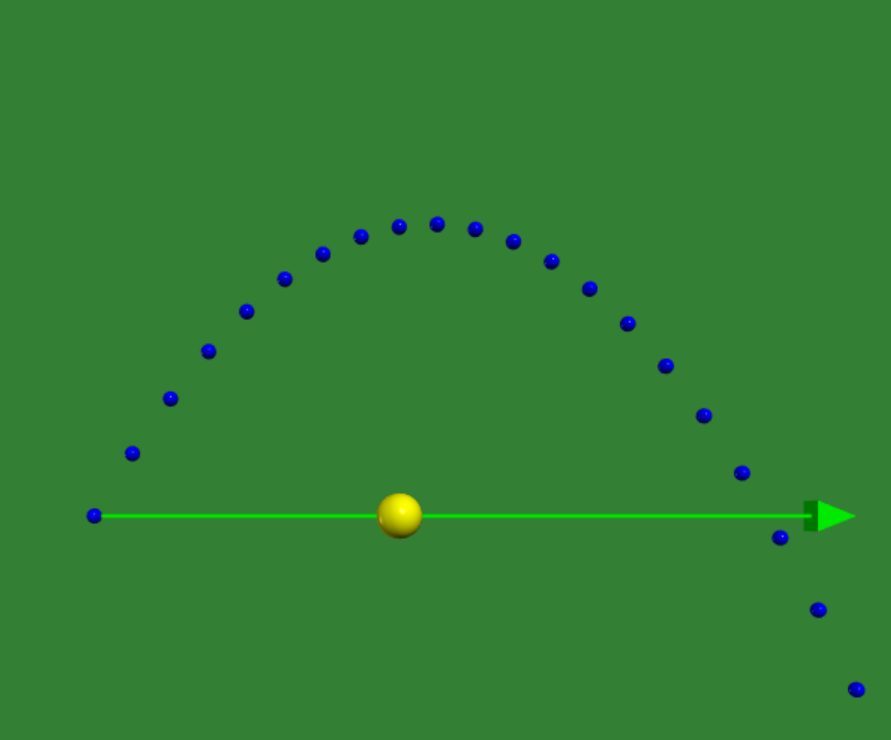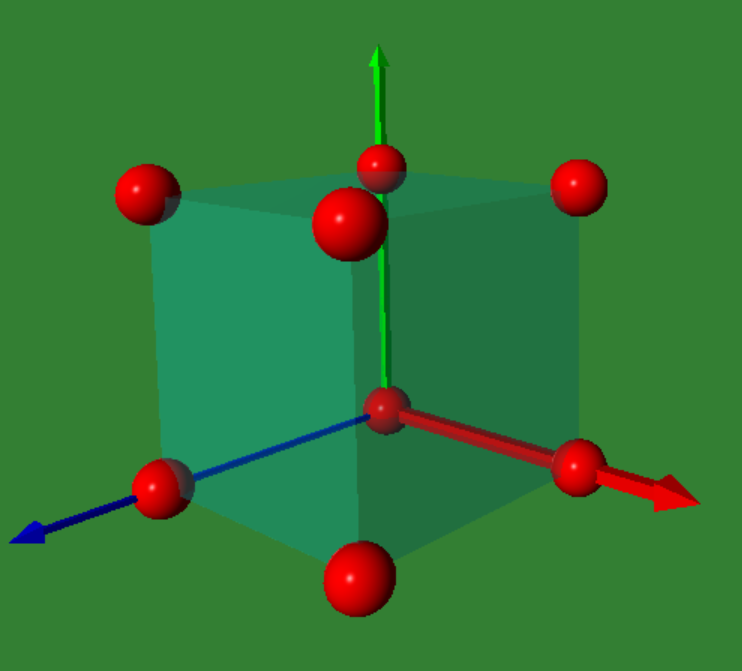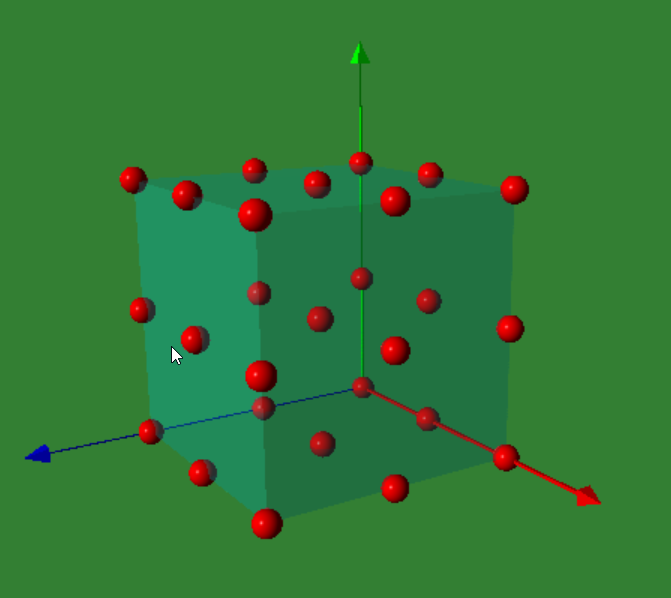
Vpython的物件
常用的物件共有7個display, arrow, box, sphere, ring, cylinder, helix 共7個。每一個物件都有自己的參數,同學可以從觀察程式與視窗中的物件樣式得知。 - display:開啟一個動畫播放的視窗, 視窗的寬(width)和高(height),中心點的座標(center),背景顏色(background),視窗的觀看方向(forward)
- arrow:箭頭,箭頭的位置(pos),軸向(axis),箭頭的大小(shaftwidth)和顏色(color)
- box:盒子,盒子的中心點位置(pos),盒子的長寬高(size),盒子的顏色(color),盒子的透明度(opacity)
- sphere:球,球的球心位置(pos),半徑(radius),顏色(color)
- ring:圓環,圓環的環心位置(pos),圓環的半徑(radius),圓環的寬度(width)
- cylinder:圓柱體,圓柱體的底面圓心座標(pos),圓柱體的半徑(radius),圓柱體的軸心向量(axis)
- helix:螺旋線,螺旋線的底端座標(pos),螺旋軸向量(axis),螺旋的半徑(radius),螺旋線的寬度(width)
'''
1. display:開啟一個動畫播放的視窗, 視窗的寬(width)和高(height),
中心點的座標(center),背景顏色(background),視窗的觀看方向(forward)
2. arrow:箭頭,箭頭的位置(pos),軸向(axis),箭頭的大小(shaftwidth)和顏色
(color)
3. box:盒子,盒子的中心點位置(pos),盒子的長寬高(size),盒子的顏色(color),盒
子的透明度(opacity)
4. sphere:球,球的球心位置(pos),半徑(radius),顏色(color)
5. ring:圓環,圓環的環心位置(pos),圓環的半徑(radius),圓環的寬度(width)
6. cylinder:圓柱體,圓柱體的底面圓心座標(pos),圓柱體的半徑(radius),圓柱體
的軸心向量(axis)
7. helix:螺旋線,螺旋線的底端座標(pos),螺旋軸向量(axis),螺旋的半徑
(radius),螺旋線的寬度(width)
'''
GlowScript 2.9 VPython
scene = display(width=800, height=500,center=vec(1, 1, 0),
background=vec(0.2,0.5,0.2), forward=vec(-0.2,-0.2,-1))
Xaxis=arrow(pos=vec(0,0,0), axis=vec(6,0,0), shaftwidth=0.05, color=vec(1,0,0))
Yaxis=arrow(pos=vec(0,0,0), axis=vec(0,6,0), shaftwidth=0.03, color=vec(0,1,0))
Zaxis=arrow(pos=vec(0,0,0), axis=vec(0,0,6), shaftwidth=0.02, color=vec(0,0,1))
box1=box(pos=vec(0,0,0),size=vec(3,3,3), color=color.cyan, opacity=0.2)
ball1 = sphere(pos=vec(3,2,1), radius = 0.5, color=color.yellow)
ball2 = sphere(pos=vec(0,1,0), radius = 0.2, color=color.red)
ring1=ring(pos=vec(4,0,0), axis=vec(1,0,0),radius=1, thickness=0.1)
gun=cylinder(radius=0.5,pos=vec(0,0,2),axis=vec(0,0,2), color=color.blue)
spring1 = helix(pos=vec(0,0,0), axis=vec(0,3,0), color=color.black,
radius=0.5, thickness=0.05)
|

立方體
在下面的程式中我們將學習如何確定的立方體的頂角座標,並且在那個座標放上一個紅色的球。 - 列表與向量的差異 list vs. vector
- 使用一個列表把正方形的頂點座標的單位向量正確列出r=[[..],[..],...]
- 把球放到正確的位置balls[i].pos=...
GlowScript 2.9 VPython
scene = display(width=800, height=800,center=vec(1, 1, 0),
background=vec(0.2,0.5,0.2), forward=vec(-0.2,-0.2,-1))
L=1;Lx=1.5; Nb=8
Xaxis=arrow(pos=vec(0,0,0), axis=vec(Lx,0,0), shaftwidth=0.05, color=vec(1,0,0))
Yaxis=arrow(pos=vec(0,0,0), axis=vec(0,Lx,0), shaftwidth=0.03, color=vec(0,1,0))
Zaxis=arrow(pos=vec(0,0,0), axis=vec(0,0,Lx), shaftwidth=0.02, color=vec(0,0,1))
box1=box(pos=vec(L/2.,L/2.,L/2.),size=vec(L,L,L), color=color.cyan, opacity=0.2)
balls=[sphere(radius=0.1,color=color.red) for i in range(Nb)]
for i in range(2):
for j in range(2):
for k in range(2):
n=i*4+j*2+k
balls[n].pos=vec(k,j,i)
print (n,balls[n].pos)
|
|
|
============輸出:=============
0 < 0, 0, 0 >
1 < 1, 0, 0 >
2 < 0, 1, 0 >
3 < 1, 1, 0 >
4 < 0, 0, 1 >
5 < 1, 0, 1 >
6 < 0, 1, 1 >
7 < 1, 1, 1 >
|
3x3x3立方體
GlowScript 2.9 VPython
scene = display(width=800, height=800,center=vec(1, 1, 0),
background=vec(0.2,0.5,0.2), forward=vec(-0.2,-0.2,-1))
L=4; Lx=6; m=3; Nb=m**3
Xaxis=arrow(pos=vec(0,0,0), axis=vec(Lx,0,0), shaftwidth=0.05, color=vec(1,0,0))
Yaxis=arrow(pos=vec(0,0,0), axis=vec(0,Lx,0), shaftwidth=0.03, color=vec(0,1,0))
Zaxis=arrow(pos=vec(0,0,0), axis=vec(0,0,Lx), shaftwidth=0.02, color=vec(0,0,1))
box1=box(pos=vec(L/2.,L/2.,L/2.),size=vec(L,L,L), color=color.cyan, opacity=0.2)
balls=[sphere(radius=0.2,color=color.red) for i in range(Nb)]
r=[[k%m,(int(k/m))%m,int(k/m**2)] for k in range(m**3)]
for i in range(m**3):
balls[i].pos=vec(r[i][0]*2,r[i][1]*2,r[i][2]*2)
print (i,r[i],balls[i].pos)
|
|
|
============輸出:=============
0 [0, 0, 0] < 0, 0, 0 >
1 [1, 0, 0] < 2, 0, 0 >
2 [2, 0, 0] < 4, 0, 0 >
3 [0, 1, 0] < 0, 2, 0 >
4 [1, 1, 0] < 2, 2, 0 >
5 [2, 1, 0] < 4, 2, 0 >
6 [0, 2, 0] < 0, 4, 0 >
7 [1, 2, 0] < 2, 4, 0 >
8 [2, 2, 0] < 4, 4, 0 >
9 [0, 0, 1] < 0, 0, 2 >
10 [1, 0, 1] < 2, 0, 2 >
11 [2, 0, 1] < 4, 0, 2 >
12 [0, 1, 1] < 0, 2, 2 >
13 [1, 1, 1] < 2, 2, 2 >
14 [2, 1, 1] < 4, 2, 2 >
15 [0, 2, 1] < 0, 4, 2 >
16 [1, 2, 1] < 2, 4, 2 >
17 [2, 2, 1] < 4, 4, 2 >
18 [0, 0, 2] < 0, 0, 4 >
19 [1, 0, 2] < 2, 0, 4 >
20 [2, 0, 2] < 4, 0, 4 >
21 [0, 1, 2] < 0, 2, 4 >
22 [1, 1, 2] < 2, 2, 4 >
23 [2, 1, 2] < 4, 2, 4 >
24 [0, 2, 2] < 0, 4, 4 >
25 [1, 2, 2] < 2, 4, 4 >
26 [2, 2, 2] < 4, 4, 4 >
|
| | 


